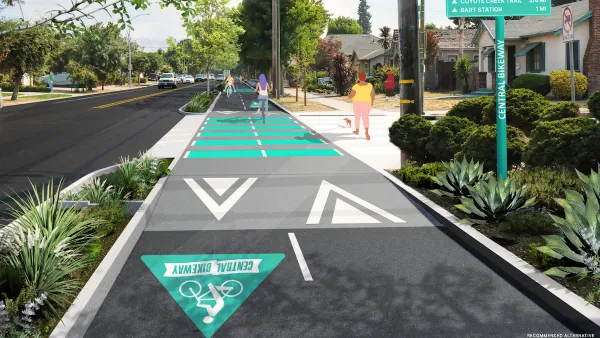A policy released by the California Department of Transportation in December will require Complete Streets elements in all state road projects.

The California Department of Transportation (Caltrans) has issued a new policy that "recognizes that streets are not only used for transportation but are also valuable community spaces," acknowledging the need to prioritize infrastructure for pedestrians, bike riders, and transit users in every Caltrans project. According to Melanie Curry, the policy solidifies the goals laid out in a prior Complete Streets plan from 2014. The new plan provides a list of "high-priority implementation actions" meant to train engineers and embed design flexibility and street safety design principles into Caltrans projects.
As Curry notes, "One thing the list reveals is that Caltrans is still taking the first steps towards truly incorporating Complete Streets into its projects, despite years of talking about it." Nevertheless, the new policy takes a stronger stance on Complete Streets elements, making them a required rather than recommended component of projects.
"The new policy states, unequivocally, that the priority of the state transportation department is 'to encourage and maximize walking, biking, transit, and passenger rail' for all kinds of reasons, including climate, health, equity, and environmental ones, as well as 'to foster socially and economically vibrant, thriving, and resilient communities.'" While Complete Streets advocates object to some of Caltrans' bike policies—such as allowing minimally protective sharrows on high-speed streets—the shift in focus could have a significant impact on how road projects across the state are designed and implemented.
FULL STORY: Caltrans Officially Embraces Complete Streets in All Projects

Planetizen Federal Action Tracker
A weekly monitor of how Trump’s orders and actions are impacting planners and planning in America.

Silicon Valley ‘Bike Superhighway’ Awarded $14M State Grant
A Caltrans grant brings the 10-mile Central Bikeway project connecting Santa Clara and East San Jose closer to fruition.

Amtrak Cutting Jobs, Funding to High-Speed Rail
The agency plans to cut 10 percent of its workforce and has confirmed it will not fund new high-speed rail projects.

California Set to Increase Electric Truck Chargers by 25%
The California Transportation Commission approved funding for an additional 500 charging ports for electric trucks along some of the state’s busiest freight corridors.

21 Climate Resilience Projects Cancelled by the EPA
The federal government has pulled funding for at least 21 projects related to farming, food systems, and environmental justice to comply with one of Trump’s early executive orders.

Trump Executive Order on Homelessness Calls for Forced Institutionalization
The order seeks to remove legal precedents and consent decrees that prevent cities from moving unhoused people from the street to treatment centers.
Urban Design for Planners 1: Software Tools
This six-course series explores essential urban design concepts using open source software and equips planners with the tools they need to participate fully in the urban design process.
Planning for Universal Design
Learn the tools for implementing Universal Design in planning regulations.
Yukon Government
Caltrans
New Jersey Institute of Technology
Mpact (founded as Rail~Volution)
City of Camden Redevelopment Agency
City of Norman, Oklahoma
City of Portland
City of Laramie





























